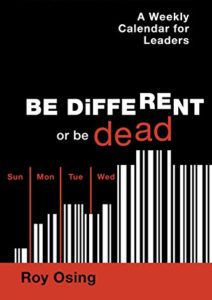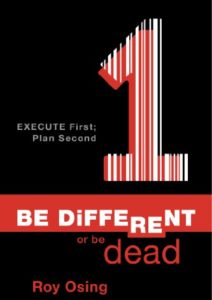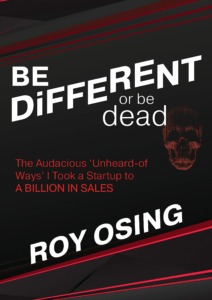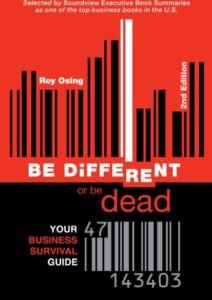Having ‘line of sight’ is the skill that will set you apart from every other sales leader.
Some experts believe that a staggering 95% of employees in an organization are either unaware of or do not understand the strategy.
No wonder execution fails!
One of the biggest issues in any organization is the lack of congruence between what the strategy says and what people do on a day-to-day basis
The strategy says one thing and not only do people do another, they do different things out of sync with the strategy.
Massive inconsistency and dysfunction results.
This is a failure of leadership.
Leadership tends to place more focus on direction-setting rather than on determining how the strategy will be executed.
Precision is applied to getting the strategy exactly ‘right’ and less attention is given to how it will be implemented in the trenches where the real work gets done.
The gap between strategic intent and actual results is due to this skewed attention. If only 20% of leadership’s attention is placed on the details of how the strategy will be implemented, the strategy will likely be hit and miss as employees find it necessary to execute the plan the way they believe it should.
Effective strategy execution in sales occurs when there is clarity between the functional roles that employees play in the organization and the organization’s strategy.
It is about translating the strategy into what it means to each sales function involved in delivering it. What specifically should inside sales do differently? The sales analyst? The sales manager?
If, at the most granular level, each employee on the sales team doesn’t know how to behave and what results to produce within the context of the new direction, change will simply not happen and improved results expected by the new business plan won’t be achieved.
Line of sight
Line of sight to the strategy means what it implies; each sales employee can ‘see’ the strategy from their position and they understand what they specifically need to do to contribute to the strategy.
If direct line of sight is defined for every role, flawless execution results whereas indirect line of sight results in people having a clouded understanding of what action the strategy demands.
Many sales leaders absolve themselves of ensuring activity and strategy are aligned. It gets relegated to sales managers to sort out by declaring their priorities that they contend are homeomorphic with the overall organization’s strategic imperatives.
The problem with this process is that subjectivity is introduced at a very high level in the organization and is magnified again and again as teams are asked to do the same thing through middle and junior sales management levels.
And the tipping point, of course, is that sales leadership doesn’t approve detailed functional plans which would at least show whether they were bordering on out-of-alignment or not.
Any inconsistencies between activity and strategy at the highest level in an organization are multiplied by an order of magnitude factor before it reaches the frontline sales people.
Under these conditions it’s not difficult to see why strategy and organizational activity diverge and not converge.
What can sales leadership do about this problem?
First, ease the precision around the strategy creation and tighten it up around execution. Get comfortable with getting the plan just about right and applying rigour to implementation and adjusting the plan on the run.
Next, take ownership of aligning organizational activity to strategy.
Alignment Plans
Institutionalize ‘Alignment Plans’ with sales managers; ask for sufficient granularity to the determination of whether or not a team has a direct line of sight to the strategy or not. Make them work at it until they get it right and your leadership team approves.
Alignment Plans submitted to the sales leader should:
- Define the key elements of the strategy that everyone in the organization must align with.
There are many dimensions to any strategy but it is critical to prioritize and focus on the critical ones. Greater alignment success will occur by focusing on a handful of the critical strategic imperatives rather than trying to ‘herd the cats’ around a dozen.
- Define what needs to change in every sales team with an action plan to achieve it.
If the organization is pursuing a new or revised strategic direction, there will most certainly be projects, company values, people skills, and technology that will have to be re-vectored to enable the execution of the new plan. Details of everything that needs to change must be defined in detail.
- Identify activities, projects and behaviours that have to be dropped in order to take on new activities required for alignment.
Leadership is just as much about what has to be stopped as it is about what has to be started.
If out-of-alignment activity is not stopped, additional unnecessary resources will be most certainly requested. All non-strategic activity must be isolated and resources removed and redeployed to new challenges that must be undertaken.
Personal initiative
If you’re a sales employee, take personal initiative to align your own work priorities to what the organization wants to achieve.
Successful sales careers are built on the backs of the organization’s strategy and those that execute more effectively than others are quicker to reach their personal goals.
These personal actions will propel you forward.
Translate for others
Help other sales teams translate what the strategy means to them. Once you have determined your own line of sight, help others through the same process.
Everyone needs to understand the new things they will have to do and the CRAP they will have to dispose of. Unless this translation for all sales employees is done, the organization will be frozen in momentum management and no progress in the new direction will be achieved.
Get involved in organizing and leading workshops with various departments in the company and explore a new blueprint for each that represents the new course for them to follow.
The role of translating the new strategy for various sales groups is one that rarely gets performed. It’s a difficult task as it requires an intimate level of understanding of the strategy. You can’t drill a strategy down into individual action if you don’t truly understand it at a detailed level.
If you’re a sales leader, you must dedicate much more of your time seeing that people treat this as a priority and hold them accountable.
Wander through the workplace asking people to clarify the top three things they are going to do to help deliver the new strategy and what dozen-or-so things they are going to give up.
And get the expectations hard wired into the performance planning process. It is the difference between an effective one where everyone is working in parallel to support a common purpose, and a dysfunctional one where people are working at odds with one another to deliver some things that are on strategy and other things that are not.
Synchronized outcomes release the power of execution – and competitive advantage; inconsistent outcomes zap the energy of the organization, encumber execution and impair competitive success.
Set your calendar
Let the organization’s strategy guide your daily calendar. The ultimate manifestation of direct line of sight is a calendar composed only of activities relating to the outcomes you have deemed necessary for you to deliver the new strategy.
If you can’t strategically relate a particular activity you plan to do on a given day, question why it is occupying your time.
Zero base your calendar and build it through the weeks and months ahead in the image of your strategy. If you are in a sales leadership position, ask to see the calendars of those reporting to you. Is each of them doing the things required of the new direction or are they continuing on as custodians of the past?
Communicate the strategy personally
Communicate face to face with others in your organization as the most effective way of injecting the emotional component necessary to get people to believe and act.
Email blasts to a broad distribution list, employee newsletters and other mass means of communication don’t work as effectively. Use technology like ZOOM if physical distancing is a challenge. These mass communications vehicles preclude the ability for people to engage in a conversation to enhance their understanding of where the organization is going.
You need to press the flesh even if it’s virtual, and make it matter by showing up in person, explaining the strategy and answering the tough questions.
In non-pandemic times, I used ‘Infonet sessions’ to communicate the company’s strategy to all employees.
They required high levels of energy and were extremely time consuming, but what else could be more important?
People in the organization need to understand where it is going and they have a right to challenge it if they are not convinced it is appropriate. You can’t capture their hearts and minds if you’re a ‘no show’.
Use the strategy as the context for solving problems
When confronted by a business problem or issue, always assess it and talk about it with others from the perspective of your strategy. Create the strategic context for the discussion and then assess your options. What does your strategy suggest is the appropriate action to take?
It’s an effective way to increase understanding and awareness of your strategy and establish you as a leader and the strategy hawk for your organization.
People suddenly forget that they have set a new course in motion for the organization and they look for solutions to problems in the old strategic context.
The opposite is also true; people often don’t relate the visible changes being made in their organization to the new strategic direction that has been put in motion. They don’t get that the cause of the changes they are witnessing is the new strategy.
Assume the role of connecting the dots for people in your organization. Reinforce that the changes that everyone is seeing are the result of your new strategy.
Line of sight leadership is necessary to build teamwork and commitment to the organization’s strategic intent. Take a personal role is making it an essential ingredient in your sales culture.



















Comments